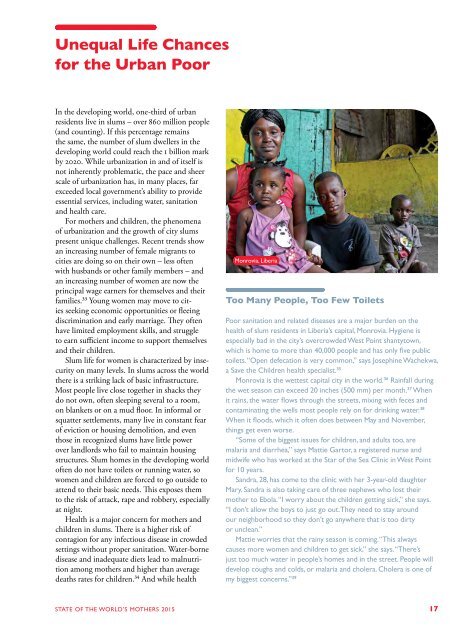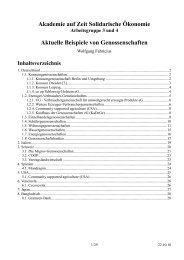sowm_2015__int__africa_full_report_low_res
sowm_2015__int__africa_full_report_low_res
sowm_2015__int__africa_full_report_low_res
Create successful ePaper yourself
Turn your PDF publications into a flip-book with our unique Google optimized e-Paper software.
Unequal Life Chances<br />
for the Urban Poor<br />
In the developing world, one-third of urban<br />
<strong>res</strong>idents live in slums – over 860 million people<br />
(and counting). If this percentage remains<br />
the same, the number of slum dwellers in the<br />
developing world could reach the 1 billion mark<br />
by 2020. While urbanization in and of itself is<br />
not inherently problematic, the pace and sheer<br />
scale of urbanization has, in many places, far<br />
exceeded local government’s ability to provide<br />
essential services, including water, sanitation<br />
and health care.<br />
For mothers and children, the phenomena<br />
of urbanization and the growth of city slums<br />
p<strong>res</strong>ent unique challenges. Recent trends show<br />
an increasing number of female migrants to<br />
cities are doing so on their own – less often<br />
with husbands or other family members – and<br />
an increasing number of women are now the<br />
principal wage earners for themselves and their<br />
families. 33 Young women may move to cities<br />
seeking economic opportunities or fleeing<br />
discrimination and early marriage. They often<br />
have limited employment skills, and struggle<br />
to earn sufficient income to support themselves<br />
and their children.<br />
Slum life for women is characterized by insecurity<br />
on many levels. In slums across the world<br />
there is a striking lack of basic infrastructure.<br />
Most people live close together in shacks they<br />
do not own, often sleeping several to a room,<br />
on blankets or on a mud floor. In informal or<br />
squatter settlements, many live in constant fear<br />
of eviction or housing demolition, and even<br />
those in recognized slums have little power<br />
over landlords who fail to ma<strong>int</strong>ain housing<br />
structu<strong>res</strong>. Slum homes in the developing world<br />
often do not have toilets or running water, so<br />
women and children are forced to go outside to<br />
attend to their basic needs. This exposes them<br />
to the risk of attack, rape and robbery, especially<br />
at night.<br />
Health is a major concern for mothers and<br />
children in slums. There is a higher risk of<br />
contagion for any infectious disease in crowded<br />
settings without proper sanitation. Water-borne<br />
disease and inadequate diets lead to malnutrition<br />
among mothers and higher than average<br />
deaths rates for children. 34 And while health<br />
Monrovia, Liberia<br />
Too Many People, Too Few Toilets<br />
Poor sanitation and related diseases are a major burden on the<br />
health of slum <strong>res</strong>idents in Liberia’s capital, Monrovia. Hygiene is<br />
especially bad in the city’s overcrowded West Po<strong>int</strong> shantytown,<br />
which is home to more than 40,000 people and has only five public<br />
toilets. “Open defecation is very common,” says Josephine Wachekwa,<br />
a Save the Children health specialist. 35<br />
Monrovia is the wettest capital city in the world. 36 Rainfall during<br />
the wet season can exceed 20 inches (500 mm) per month. 37 When<br />
it rains, the water f<strong>low</strong>s through the streets, mixing with feces and<br />
contaminating the wells most people rely on for drinking water. 38<br />
When it floods, which it often does between May and November,<br />
things get even worse.<br />
“Some of the biggest issues for children, and adults too, are<br />
malaria and diarrhea,” says Mattie Gartor, a registered nurse and<br />
midwife who has worked at the Star of the Sea Clinic in West Po<strong>int</strong><br />
for 10 years.<br />
Sandra, 28, has come to the clinic with her 3-year-old daughter<br />
Mary. Sandra is also taking care of three nephews who lost their<br />
mother to Ebola. “I worry about the children getting sick,” she says.<br />
“I don’t al<strong>low</strong> the boys to just go out. They need to stay around<br />
our neighborhood so they don’t go anywhere that is too dirty<br />
or unclean.”<br />
Mattie worries that the rainy season is coming. “This always<br />
causes more women and children to get sick,” she says. “There’s<br />
just too much water in people’s homes and in the street. People will<br />
develop coughs and colds, or malaria and cholera. Cholera is one of<br />
my biggest concerns.” 39<br />
STATE OF THE WORLD’S MOTHERS <strong>2015</strong> 17




